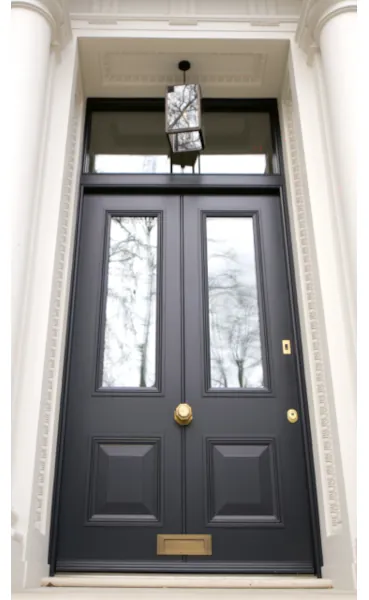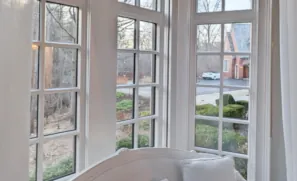FULLY CUSTOM
Forced Entry Resistant Doors
Last Updated January 5th, 2022
Table of Contents
- Forced entry versus ballistics
- Forced entry attacks
- Forced entry resistance certification
- Included security features
- Custom design options

Is Bullet or Forced Entry Resistance More Critical?
Typically when people think of a highly secure door, they think bulletproofing is the most important feature. It is reasonable to presume that if a door can stop the explosive force of a bullet than it can certainly stop lesser attacks from a perpetrator. In fact, this isn’t the case: forced entry resistance is a separate and generally more important factor.
A human attacking a door with various tools is the greater threat, in most cases. Unlike a bullet, a person can calibrate their movements precisely and use leverage – a bullet is sharp and travels at incredible speeds, but is lightweight and moves linearly.
How Doors Are Defeated
Several methods exist for defeating a door, even one that has a bulletproof door leaf! Some examples that don’t require any door-leaf penetration include:
- Defeating the door’s hinges, thus neutralizing the security provided by the handle-side dead-bolt(s).
- Picking the door’s lock cylinder, or drilling through it.
- Using a prybar to temporarily bend the door leaf or frame out of level or plumb. Doing so can pop a door’s lock right out of it’s frame.
The larger the pry bar, the easier this is, due to the basic physics laws of using a fulcrum for leverage. An average 180lb man can bench press about 150lbs. A 12inch pry bar could multiple their effort five-fold, a 36” pry bar over 10-fold!


Certified Forced Entry Resistant Doors
Various certification methods exist for forced entry resistant doors. In the European Union EN 1627 and EN 1630 is most commonly used for European forced entry doors. Some European countries have analogous versions, such as France’s AP2.

The gold standard of testing for a forced entry resistant door is the US Department of State SD-STD-01.01 Rev.G ratings. This forced entry test is the most rigorous, using multiple experts attacking simultaneously and at multiple points of the door. Time is only counted during actual attacks – any pauses are off the clock. No test better simulates a professional, organized attack on an entry point. Our forced entry resistant doors are rated to US Department of State SD-STD-01.01 FE5 or FE15. FE5 testing uses two professionals attacking for five minutes in three different areas, each: equating to a single expert attacking for 30 minutes. FE15 testing uses six professionals attacking for 15 minutes in three different areas, each: equating to a single expert attacking for over 4 hours.
SD-STD-01.01 Standard Tested Doors
SD-STD-01.01 is a U.S. Department of State standard for doors that resist both forced entry and bullets. Doors are tested by teams using various tools to assess the security of hinges, locks, and seams. Tests are timed, with levels based on time, such as 5 minutes (FE5) or 15 minutes (FE15). However, the actual testing duration often exceeds the nominal duration listed per test. Each duration (e.g., 5 minutes in an FE5 test) is actually applied per section of the door. Since each door is attacked in at least three sections, the FE5 test is a total of 15 attack minutes, and the FE15 test is a total of 45 attack minutes. Ballistic tests involve firing rounds such as 5.56mm and 7.62mm NATO at the door to make sure it holds up. Doors that pass this standard provide strong protection against even skilled, sustained attacks.

Forced Entry Door Features Include:
- Multi-layered, thick-gauge galvanized steel core
- Lap welded and corrugated steel optimized for strength
- L-shape door leaf interlocks with frame to neutralize pry attacks
- 16-20 high-strength steel locking bolts
- 2″ Rockwool provides panic room sound insulation
- Fixed hinge-side bolts render hinge attacks useless
- Hardened steel channels in frame receive safe door bolts
- Armored shims encase 4″ lag bolts securing the frame to wall
- Configurable for in-swing or out-swing
- Optional ballistic steel for UL Level 3 and UL Level 8


Custom Forced Entry Resistant Doors
All our forced entry resistant doors are custom manufactured to the client’s specifications, including:
- Custom width and height
- Cladding, including solid wood and stainless steel
- Unlimited milling designs
- Factory painting to any RAL color
- Single door, double door, sidelight and transom configurations
- Small, half and full glass in door leaf
- Matching high-security door frame
- Several all-side locking bolt options
- Bullet resistance to handgun or rifle protection levels
Other products: Bulletproof blankets and High-security french doors
Forced Entry Resistant Door Testing
This video demonstrates how well a forced-entry-resistant door by Fortified Estate holds up against a break-in attempt using a heavy-duty bar. Watch how it handles the impact and stays secure under pressure.
FREQUENTLY ASKED QUESTIONS
Forced-entry resistant doors are specially designed to prevent external intelligent threats, such as burglaries, mobs, or even professional attacks. Basic doors can withstand kicking or bodily force, but more advanced doors can stop anything from axes to sledgehammers to battering rams. These doors provide enhanced security by delaying or preventing intruders from gaining entry and are built with reinforced materials and advanced locking systems.
Regular security doors provide basic protection, but forced-entry proof doors are much stronger. They use reinforced materials and advanced locks to resist long, skilled break-in attempts. Unlike regular security options, forced-entry proof doors are tested according to strict standards, like SD-STD-01.01, to prove their durability. It is easy to have a door with features that sound tough. However, actual forced entry testing is needed to ensure that there are no weak points to the door, and that it can block a sophisticated attacker from all angles and methods.
Forced-entry resistant doors are tested to meet strict security standards. The U.S. Department of State’s SD-STD-01.01 standard checks how well they hold up against expert break-in attempts. This standard is considered the gold standard for forced entry resistance, and it is the same resistance level required by US embassies. There are other forced entry resistance standards globally, such as the European standard EN 1627-1630, which includes burglary attempts, with resistance classes including RC3 and RC4 all the way up to RC6. There are also the LPS 1175 and SBD standards in the UK. Few of these standards provide the same rigor and duration of resistance as the US Department of State standards. Many of our doors also meet UL 752 standards for bullet resistance, providing reliable defense against multiple threats.
Yes, many forced-entry resistant doors are also bulletproof and use strong materials, such as steel cores and reinforced frames, that have been tested to meet ballistic standards. This way, the doors protect against both break-ins and firearm threats, giving homeowners extra peace of mind.
An SD-STD-01-01 Rev H door is a high-security door tested under the U.S. Department of State’s SD-STD-01.01 standard. This standard evaluates a door’s ability to withstand prolonged and sophisticated forced entry attempts, ensuring it provides reliable protection.
In theory, doors can be strengthened with stronger frames, better locks, and bullet-resistant panels. But this rarely will meet the dependable level of security that a purpose-built forced entry-resistant door will achieve. Upgrades could help, but there are almost certainly several weak points that would remain, including areas that are easily pried open and parts that are prone to separation. Additionally, the door is likely to function poorly, as it was not designed to handle the weight of the new armor. For optimal security and reliable operation, it’s highly recommended to use doors that are built and tested to meet forced-entry standards.
Installation time for a forced-entry resistant door depends on the door’s complexity, customization, and the home’s structure. Many doors are more suited for commercial locations and may require third-party components to be integrated. Fortified Estate doors are specially designed for residential use (as well as commercial use). While the installation requires more people on site due to the higher weight of the door, there are also numerous features built in to assist in installation, such as adjustable leveling shims. On average, it can take from a few hours to a couple of days.








